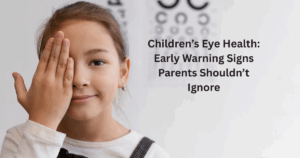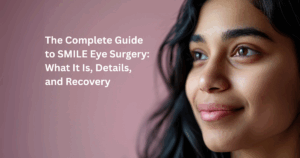When your child is learning to walk, talk, or ride a bicycle, you’re watching closely, cheering every milestone. But there’s one area of development that often goes unnoticed by parents, that is their vision. And sometimes, a condition called lazy eye, or amblyopia, can quietly interfere with how your child sees the world.
Amblyopia is also one of the most prevalent causes of vision issues in children, but it can be difficult to detect unless a correct eye examination is conducted. At Tandon Eye Hospital, we urge parents to take the correct approach as early detection is so crucial, and we’re here to make parents aware of what lazy eye is, why it occurs, and how it can be treated successfully—particularly if detected early enough.
What is Lazy Eye (Amblyopia)?
Lazy eye isn’t about a physically lazy eye—it’s a developmental problem where one eye doesn’t transmit clear pictures to the brain, so the brain uses the stronger eye more. The weaker eye gets neglected over time, and its vision doesn’t develop properly.
If not treated, amblyopia can cause lasting vision loss in the affected eye. But here’s the positive part, with proper treatment—particularly during early childhood—it’s extremely treatable.
What Causes Amblyopia?
There are a number of underlying causes due to which a child may develop a lazy eye. Some of the most frequent causes are:
- Strabismus (Crossed Eyes)
When a child’s eyes don’t align correctly, the brain gets two different pictures. To avoid double vision, the brain may begin to ignore one eye completely—resulting in amblyopia.
- Refractive Errors
If one eye is substantially more nearsighted, farsighted, or astigmatic than the other, the brain can prefer to use the more focused eye. The second eye gets unused and gets weaker over time.
- Blockage in One Eye
Anything that blocks an eye—like a droppy eyelid (ptosis) or childhood cataract—can lead to amblyopia if it’s not fixed early.
Signs and Symptoms Parents Should Watch For
Kids won’t necessarily tell you, “I can’t see well in one eye.” That’s why it’s so important to look for subtle clues, such as:
- One eye that wanders or appears “off” direction
- Poor depth perception (trouble catching a ball, clumsiness)
- Squinting or shutting one eye in order to see better
- Tilting the head often
- Frequent eye rubbing or blinking
- Complaints of headaches or eye strain
- Difficulty reading or struggling in school
There are often no noticeable symptoms in some instances, making it even more critical and that is why regular vision screenings should be done.
How is Amblyopia Diagnosed?
Amblyopia is usually detected during a comprehensive pediatric eye exam. At Tandon Eye Hospital, we utilize non-invasive, gentle testing to assess the focusing, tracking, and ability of each eye to send clear signals to the brain.
Even if the eyes of your child look fine, measuring each eye for visual acuity separately is the only reliable way of detecting amblyopia early.
Treatment Options for Lazy Eye
The aim of amblyopia treatment is to make the weaker eye stronger and persuade the brain to utilize it. Depending on the age of the child and the severity of the condition, treatment can involve:
- Corrective Eyeglasses: If refractive errors are the cause, corrective eyeglasses may be the initial and most effective treatment.
- Patching the Stronger Eye: An eye patch is placed over the stronger eye for a few hours a day, prompting the brain to employ the weaker eye and gradually enhance its vision.
- Atropine Eye Drops: In a few instances, physicians might suggest special eye drops to the stronger eye to blur its vision briefly, compelling the weaker eye to work harder—much like patching, but less invasive.
- Vision Therapy Exercises: Specific visual activities or computer programs can enhance eye coordination and stabilize visual processing in the weaker eye.
When Should You See a Doctor?
The earlier amblyopia is caught, the better the chances of full recovery. Ideally, all children should have their first eye exam by age 3, or sooner if there are any signs or risk factors.
You should consult an eye specialist immediately if:
- You notice one eye turning inward or outward
- Your child squints, tilts their head, or covers one eye frequently
- There’s a family history of eye disorders
- Your child struggles with reading, focusing, or falls behind in school
Let’s Give Your Child a Clearer Future
Your child’s vision determines the way they learn, develop, and perceive the world. At Tandon Eye Hospital, we have expertise in pediatric eye care, providing empathetic, specialized treatment for complications such as amblyopia. If diagnosed early and treated correctly, your child can enjoy lifelong healthy, balanced vision.
If there is something bothering you, don’t delay—book a pediatric eye exam today.



